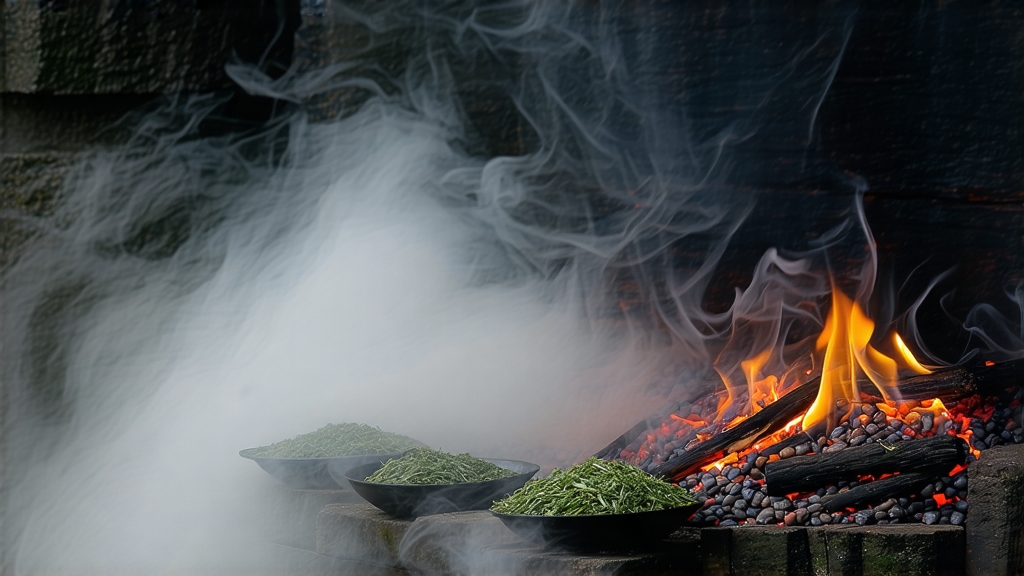
If you trace the family tree of every bold breakfast blend from London to Lahore, you will arrive at a single, mist-wrapped ridge in China’s Wuyi Mountains where the very idea of black tea was born. Locals call it Zheng Shan Xiao Zhong; the West knows it as Lapsang Souchong. More than a curiosity famed for its campfire perfume, it is the primordial black tea, the prototype that taught the world how leaf can be coaxed into copper liquor and malt-sweet complexity. To understand it is to hold a compass for the entire hemisphere of hong cha—China’s “red tea.”
History: From Ming-Era Accident to Global Obsession
Legend places the birth moment in 1568, late Ming dynasty, when a band of soldiers interrupted the spring harvest in Tongmu village. To dry the piled leaves before they spoiled, farmers rushed them over fresh pine embers. The resulting tea, dark and fragrant, traveled down the Nine-Bend River to the port of Xiamen, where Dutch traders paid in silver. By the early 1600s “Bohea” (the Fujianese pronunciation of Wuyi) had become a European luxury; Catherine of Braganza’s dowry chest carried it to London, launching the English tea habit that would redraw world maps. The East India Company tried—and failed—for two centuries to replicate the pine aroma, cementing Tongmu’s mystique. Today the original 600-hectare core is a national conservation zone; every kilo of authentic Zheng Shan leaves is tracked by satellite and sealed with a government hologram.
Micro-Terroir: Where Rock, Fog and Pine Converge
Tongmu sits at 27° N inside a granite amphitheater 1,200 m above sea level. Diurnal swings of 15 °C force slow growth, condensing amino acids. Humidity hovers at 85 %, feeding lichen that scent the air. Two native cultivars dominate—Xiao Ye Zhong (small leaf) and the rarer Ye Cha (wild tree). Their spring buds carry less tannin than Assamica varieties, yielding a naturally sweet, pine-resin substrate that absorbs smoke without turning harsh. Soil is a thin, acidic laterite laced with quartz; drainage is so abrupt that roots plunge three metres, mining minerals that translate into the tea’s tell-tale “rock rhyme” (yan yun), a lingering coolness felt in the throat minutes after swallowing.
Craft: The Eight-Step Alchemy
Authentic Lapsang is still hand-made in small batches between late April and early May.
- Plucking: only the standard “two leaves and a bud” picked before 10 a.m. while dew remains.
- Withering: trays of leaves rest on sycamore racks above ground-level corridors where pine embers smoulder at 28 °C for 8–10 hours; moisture drops to 60 %.
- Rolling: 45 minutes of kneading on bamboo mats breaks cell walls without shredding the leaf, releasing milky sap.
- Oxidation: the pile is wrapped in wet cloth and left in a pine-wood box for 3–4 hours; catechins convert to theaflavins, turning the leaf a mahogany rim with olive centre.
- Pan-firing: a 220 °C wok shock for 90 seconds halts oxidation, locking in a reddish liquor.
- Smoke-drying: the signature step. Fresh pinus massoniana and local Chinese red pine are split, resin-rich heartwood only. The fire is starved of oxygen so it smokes rather than flames. Leaves rest on sieves 1.5 m above the hearth for 6–8 hours, absorbing guaiacol and syringol—the same phenols that perfume bacon. Masters gauge readiness by sound: when the rustle becomes metallic like autumn chestnuts, the tea is done.
- Sorting: stems and broken flakes are winnowed by hand; only whole, glossy strips pass.
- Aged resting: seven days in earthen jars allows smoke to integrate, softening any acrid edge.
Styles: A Spectrum Beyond Campfire
International markets often know only the assertive “Russian Caravan” grade, but connoisseurs recognise three tiers:
- Zheng Shan Xiao Zhong (unsmoked): produced